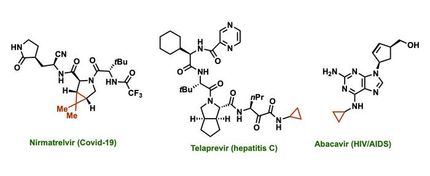Making better medicines with a handful of chemical building blocks
Advertisement
Soon, making and improving medical drugs could be as easy for chemists as stacking blocks is for a child. University of Illinois chemist Martin Burke, a pioneer of a technique that constructs complex molecules from simple chemical "building blocks," led a group that found that thousands of compounds in a class of molecules called polyenes – many of which have great potential as drugs – can be built simply and economically from a scant one dozen different building blocks.
"We want to understand how these molecules work, and synthesis is a very powerful engine to drive experiments that enable understanding," said Burke, a chemistry professor at the U. of I. and the Howard Hughes Medical Institute. "We think this is a really powerful road map for getting there.
Once you have the pieces in a bottle, you can make naturally occurring molecules, or you can change the pieces slightly to make them better. Usually, that's such a herculean task that it slows down research. But if that part becomes on-demand, you can make anything you want, and it can powerfully accelerate the drug discovery process."
In the same way that plastic building blocks of different sizes and shapes can snap together because they share a simple connector, the chemical building blocks are linked together with one simple reaction. This gives scientists freedom to build molecules that may be difficult or expensive to extract from their natural source or to make in a lab.
One advantage of the building-block approach is that it allows the researchers to mix and match parts to build many different molecules, and to omit or substitute parts to make a potentially therapeutic substance better for human health. For example, Burke's group recently synthesized a derivative of the anti-fungal medication amphotericin (pronounced AM-foe-TAIR-uh-sin), which led to a big breakthrough in understanding how this clinically vital but highly toxic medicine works and the discovery of another derivative that is nontoxic to human cells while still effective at killing fungus.
After their success in synthesizing derivatives of amphotericin, which fall into the polyene category, the researchers wondered, how many different building blocks would it take to make all the polyenes? (Polyene is pronounced polly-een.)
Looking at the structures of all the known naturally occurring polyenes – thousands in all – Burke and graduate students Eric Woerly and Jahnabi Roy focused on the smaller pieces that made up the molecules and found that many elements were common across numerous compounds. After careful analysis, they calculated that more than three-quarters of all natural polyene frameworks could be made with only 12 different blocks.
"That is the key most surprising result," Burke said. "We've had this gut instinct that there will be a set number of building blocks from which most natural products can be made. We're convinced, based on this result, that we can put together a platform that would enable on-demand assembly of complex small molecules. Then researchers can focus on exploring the function of these molecules, rather than spending all their time and energy trying to make them."
Other news from the department science
These products might interest you
Most read news
More news from our other portals
See the theme worlds for related content
Topic world Synthesis
Chemical synthesis is at the heart of modern chemistry and enables the targeted production of molecules with specific properties. By combining starting materials in defined reaction conditions, chemists can create a wide range of compounds, from simple molecules to complex active ingredients.

Topic world Synthesis
Chemical synthesis is at the heart of modern chemistry and enables the targeted production of molecules with specific properties. By combining starting materials in defined reaction conditions, chemists can create a wide range of compounds, from simple molecules to complex active ingredients.




































































